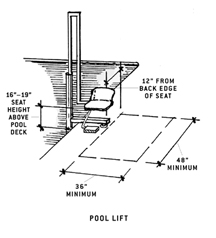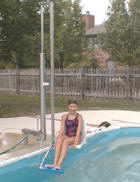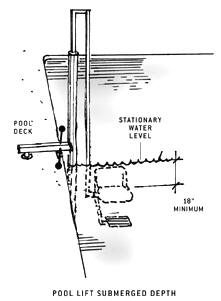Accessible Swimming Pools, Wading Pools and Spas - A Summary of Accessibility Guidelines for Recreation Facilities
Pool Lifts
Pool Lifts
Pool lifts must be located where the water level is not deeper than 48 inches. This provides the opportunity for someone to provide assistance from a standing position in the water if desired. If multiple pool lift locations are provided, only one must be where the water is less than 48 inches. If the entire pool is deeper than 48 inches, an exception allows operators to use a pool lift in any location as an accessible means of entry.
Seats
There are a variety of seats available on pool lifts and these guidelines do not specify the type of material or the type of seat required. However, lift seats must be a minimum of 16 inches wide. In the raised (load) position, the centerline of the seat must be located over the deck, a minimum of 16 inches from the edge of the pool. The deck surface between the centerline of the seat and the pool edge cannot have a slope greater than 1:48.
Although not required, seats with backs will enable a larger number of persons with disabilities to use the lift independently. Pool lift seats made of materials that resist corrosion, that provide a firm base, and that are padded are more usable. Headrests, seat belts, and additional leg support may also enhance accessibility and accommodate a wider variety of people with disabilities.
Clear Deck Space
Clear deck space must be provided to enable a person to get close enough to the pool lift seat to easily transfer from a wheelchair or mobility device. This clear deck space will ensure an unobstructed area for transfers between a mobility device and the seat. The clear deck space must be a minimum of 36 inches wide and extend forward a minimum of 48 inches from a line located 12 inches behind the rear edge of the seat. This space must be located on the side of the seat opposite the water. The slope of the clear deck space must not be greater than 1:48 (2%). This virtually flat area will make the transfer easier and safer, while still allowing water to drain away from the deck.
Seat Height
The lift must be designed so that the seat will make a stop between a minimum of 16 inches and maximum of 19 inches (measured from the deck to the top of the seat surface, when the seat is in the raised position). Lifts can provide additional stops at various heights to accommodate users of all ages and abilities.
Footrests and Armrests
Footrests and armrests provide stability for the person using the pool lift. Footrests must be provided on pool lifts, and must move together with the seat. Padding on footrests —large enough to support the whole foot—reduces the chance of injury.
Armrests are not required, however if provided, the armrest opposite the water must be removable or be able to fold clear of the seat when the seat is in the raised (load) position. This clearance is needed for people transferring between the lift and a mobility device.
Operation
Lifts must be designed and placed so that people can use them without assistance, although assistance can be provided if needed. A person must be able to call the lift when it is in either the deck or water position. It is especially important for someone who is swimming alone to be able to call the lift so she or he won’t be stranded in the water for an extended period of time.
The controls and operating mechanisms must be unobstructed when a lift is in use. A person must be able to use the lift with one hand, and the operating controls must not require tight grasping, pinching, or twisting of the wrist. Controls may not require more than five pounds of pressure to operate.
Submerged Depth
Lifts must be designed so that the seat will submerge to a minimum of 18 inches below the stationary water level. This will ensure buoyancy for the person on the lift and make it easier to enter or exit.
Lifting Capacity
Lifts must have the capability of supporting a minimum weight of 300 pounds and be capable of sustaining a static load that is at least 1.5 times the rated load. Where possible, lifts that can support a greater weight capacity are encouraged.




User Comments/Questions
Add Comment/Question